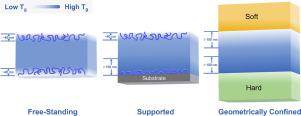Progress in Polymer Science ( IF 26.0 ) Pub Date : 2021-06-06 , DOI: 10.1016/j.progpolymsci.2021.101431 Bolin Li , Shuqing Zhang , John S. Andre , Zhan Chen

|
The glass transition temperature (Tg) of polymer thin films, one of the most important parameters to characterize the relaxation behavior of polymer chains in a thin film, has been extensively investigated. It was found that the relaxation behavior of polymer chains in a polymer thin film at different locations, e.g., near a free surface, near a buried interface, or inside a given position of the film bulk, can vary greatly. Such results are significant for both fundamental understanding of molecular behavior and practical use of polymer thin films in many important applications but have not been systematically summarized and reviewed. In this review, we look at two extensively studied and commonly used polymer thin films, i.e., poly(methyl methacrylate) (PMMA) and polystyrene (PS), as examples to systematically examine the effects of the free surface, buried interface (substrate), and geometrical confinement (encapsulated between two substrates) on the surface, interfacial, and bulk relaxation behavior of polymer thin films. Especially, the universal effects of “hard” and “soft” confinements and adsorbed nanolayer near a substrate on Tg are reviewed in detail. In addition, other important polymers such as poly(2-vinylpyridine) and the effects of other variables such as annealing are also discussed. This review elucidates variables which influence the relaxation behavior of polymer chains on the free surface, at buried interfaces, or in the bulk region of polymer thin films, providing in-depth understandings of such behavior. The systematic knowledge reported here will help to guide the future design of polymer thin films with desired properties used in a variety of applications, ranging from multilayer polymer packaging materials, polymer sheets, plastic microelectronics, to batteries and solar cells, and beyond.
中文翻译:

聚合物薄膜的松弛行为:自由表面、埋入界面和几何限制的影响
聚合物薄膜的玻璃化转变温度 ( T g ) 是表征薄膜中聚合物链松弛行为的最重要参数之一,已被广泛研究。发现聚合物薄膜中聚合物链在不同位置的弛豫行为,例如自由表面附近、埋入界面附近或膜体的给定位置内,可以有很大差异。这些结果对于分子行为的基本理解和聚合物薄膜在许多重要应用中的实际应用都具有重要意义,但尚未系统地总结和回顾。在这篇综述中,我们研究了两种广泛研究和常用的聚合物薄膜,即,聚(甲基丙烯酸甲酯)(PMMA)和聚苯乙烯(PS),作为示例,系统地检查自由表面、掩埋界面(基板)和几何限制(封装在两个基板之间)对表面、界面和体弛豫的影响聚合物薄膜的行为。特别是,“硬”和“软”限制以及靠近衬底的吸附纳米层对T g的普遍影响被详细审查。此外,还讨论了其他重要的聚合物,如聚(2-乙烯基吡啶)和其他变量(如退火)的影响。这篇综述阐明了影响聚合物链在自由表面、掩埋界面或聚合物薄膜本体区域的松弛行为的变量,提供了对这种行为的深入理解。这里报告的系统知识将有助于指导未来设计具有所需特性的聚合物薄膜,用于各种应用,包括多层聚合物封装材料、聚合物片材、塑料微电子、电池和太阳能电池等。









































 京公网安备 11010802027423号
京公网安备 11010802027423号